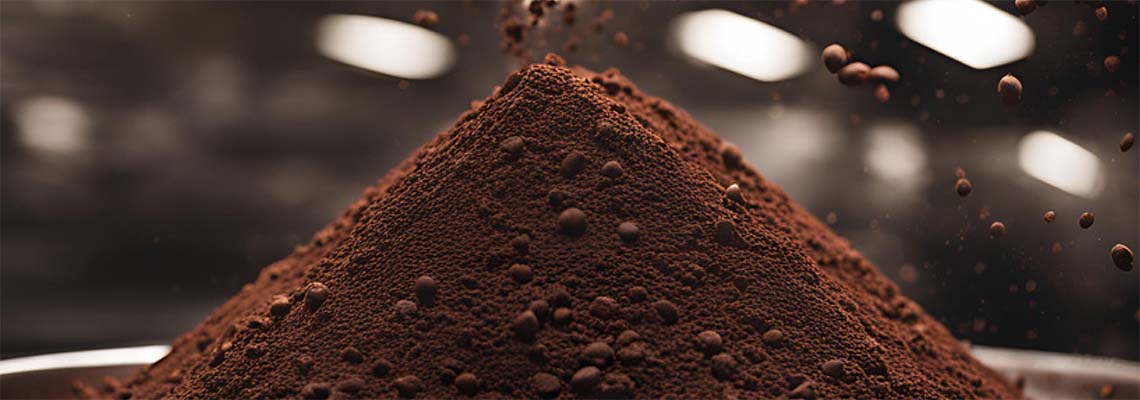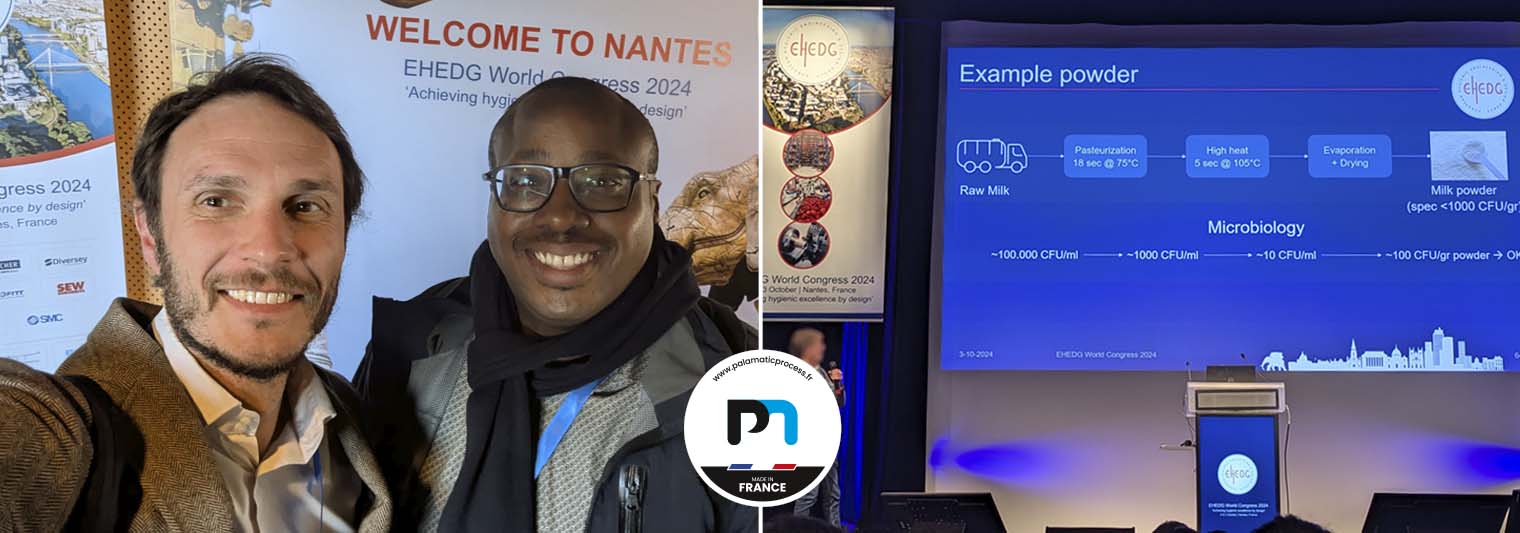The food industry is a dynamic sector where food safety and hygiene are top priorities. Among the many challenges faced by companies in this sector, excessive water washing is often underestimated
While this practice may seem like an obvious solution to ensure the cleanliness of facilities, it can actually promote bacterial growth and increase food safety risks.
This issue was at the centre of discussions during the EHEDG World Congress 2024 in Nantes, where experts such as Jean-Luc Louis, Head of the 3S service at Palamatic Process, shared their knowledge and innovative solutions.
The problem of excessive water washing in the food industry
Water washing is a crucial step in the cleaning process of food industry equipment. However, this practice can have negative consequences if not properly managed. Closed equipment designs, for example, can retain water after washing, creating environments conducive to bacterial growth. This situation can lead to cross-contamination, compromising the food safety of finished products.
Closed designs, with excessive casings, prevent the detection of dirt and easy access for cleaning, while horizontal plates can create retention areas that hinder the draining of washing water. In contrast, open design is a fundamental principle of hygienic design, aimed at simplifying cleaning and ensuring better hygiene of equipment.
The possible consequences of excessive water washing of equipment
When equipment is poorly designed, the consequences of excessive water washing can be disastrous for food companies. A non-hygienic equipment design can lead to bacterial growth, increasing the risks of foodborne illnesses. Furthermore, cleaning non-hygienic equipment can require more time and energy, leading to production losses and wasted energy.
Without proper solutions, companies risk non-compliance with European and global food safety standards (CE1935/2004, FDA) and may fail to meet the requirements imposed by entities such as the EHEDG (European Hygienic Engineering & Design Group).
Failure to comply with these standards can result in sanctions, product recalls, and a loss of consumer trust. EHEDG standards are internationally recognised guidelines for the hygienic design of food industry equipment and facilities.
Solutions proposed by the EHEDG
Through its guidelines, the EHEDG proposes concrete approaches to limit water retention areas, promote open designs, and optimise equipment accessibility. These concepts were at the heart of discussions during the EHEDG World Congress 2024 in Nantes, where experts discussed best practices to ensure food safety and the hygiene of installations.
EHEDG principles
EHEDG principles are summarised in several reference documents, such as GL 08, GL 52, and GL 58. These documents provide detailed guidelines on the hygienic design of food industry equipment and facilities. For example, GL 08 deals with general principles of hygienic design, while GL 52 and GL 58 focus on specific aspects such as construction materials and cleaning systems.
The benefits of hygienic design
Hygienic equipment design not only improves the cleaning of facilities but also enhances process durability and reduces environmental impact. By applying EHEDG principles, companies can reduce microbiological risks, improve cleaning efficiency, and achieve savings in water and energy consumption.

The transformation of industrial processes
Improving cleaning efficiency
Improving cleaning efficiency is another crucial aspect of food safety. Equipment designed according to EHEDG standards is easier to clean, reducing the time and resources needed for cleaning. This results in time and cost savings for companies, as well as improved productivity.
Savings on water consumption
Water consumption is a major issue for food companies. Equipment designed according to EHEDG standards helps reduce the water needed for cleaning, contributing to process sustainability and reducing environmental impact. This also enables companies to save on water and energy costs.
Palamatic Process' technological offering
At Palamatic Process, the 3S service, led by Jean-Luc Louis, integrates EHEDG concepts into every project, ensuring tailor-made solutions that meet the highest hygiene standards. Equipment designed according to EHEDG standards allows significant savings in energy, cleaning, and sustainability.
Tailor-made solutions
Palamatic Process offers customised solutions to meet the specific needs of each company. Equipment is designed with EHEDG requirements in mind, ensuring hygienic design and optimal food safety. Palamatic Process solutions are tailored to the various sectors of the food industry, offering maximum flexibility and efficiency.
Compliance with international standards
The EasyClean equipment range from Palamatic Process specifically meets the requirements of the food industry, offering tailor-made solutions for the handling of powders and food ingredients.
Savings on energy and cleaning
Equipment designed according to EHEDG standards allows for significant savings in energy and cleaning. By reducing water retention areas and incorporating open designs, Palamatic Process equipment is easier to clean, reducing the time and resources needed for cleaning. This translates into energy and cost savings for companies, as well as improved productivity.
Sustainable development
Palamatic Process is also committed to sustainable development. Equipment designed according to EHEDG standards contributes to reducing environmental impact by minimising water and energy consumption. This enables companies to reduce their ecological footprint and contribute to environmental protection.

Responding to the challenges of the food industry
By integrating EHEDG principles into their processes, food companies can not only comply with international standards but also improve their overall performance. Palamatic Process's hygienic design solutions offer a concrete response to the challenges of the food industry, enabling companies to ensure food safety and hygiene in their installations.
Compliance and food safety
Compliance with international food safety standards is essential for food companies. By incorporating EHEDG concepts into their processes, companies can ensure compliance with regulations and protect consumer health. Palamatic Process solutions are designed to meet the strictest requirements, offering optimal food safety.
Improving overall performance
Palamatic Process's hygienic design solutions allow companies to improve their overall performance. By reducing microbiological risks, improving cleaning efficiency, and achieving savings in water and energy consumption, companies can increase their productivity and profitability. This also helps reduce operational costs and maximise profits.
A reference for food safety
By adopting Palamatic Process's hygienic design solutions, companies can position themselves as leaders in food safety. By ensuring compliance with international standards and improving their overall performance, companies can stand out from the competition and gain consumer trust. This also helps strengthen the company's reputation and foster customer loyalty.

If you have a project in mind, I'm available to help you.
Loïc, powder expert
In conclusion
Excessive water washing in the food industry is a major issue that can have disastrous consequences if equipment is not properly designed. EHEDG guidelines provide concrete approaches to limit water retention areas, promote open designs, and optimise equipment accessibility.
At Palamatic Process, the 3S service, led by Jean-Luc Louis, incorporates these concepts into every project, ensuring tailor-made solutions that meet the highest hygienic standards.
By integrating EHEDG principles into their processes, food companies can not only comply with international standards but also improve their overall performance and become leaders in sustainable food safety.
Contact our international experts to discover how their hygienic design solutions can transform your company and ensure the food safety of your products.
Check out the interview with Jean-Luc Louis at the EHEDG World Congress 2024 in Nantes.




















